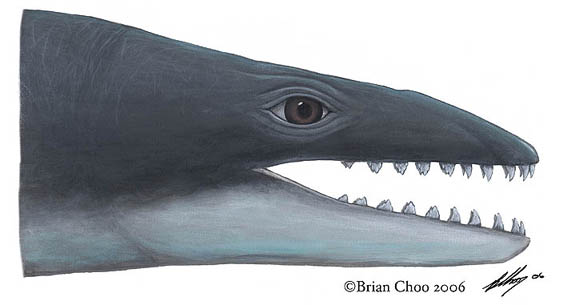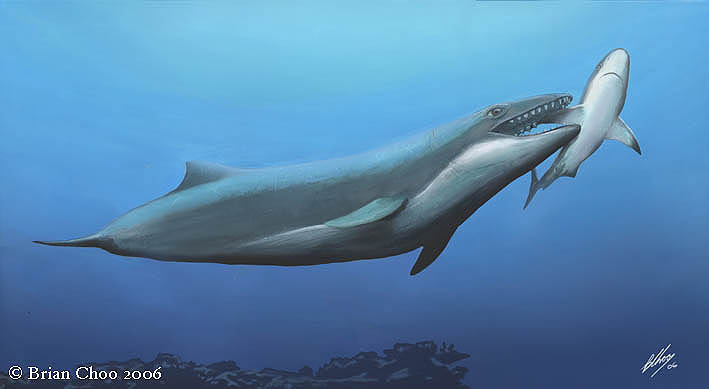c. 25 million years ago, southern Victoria.
In the waters off southeastern Australia, a small shark gets the last surprise of its life as a 3.5 metre-long predatory whale closes in for the kill. The whale is Janjucetus (pronounced "jan-ju-see-tus"), a remarkable creature whose fossil remains have opened new insights into the early evolution of the largest animals to ever live.
We are all familiar with the living baleen whales, a group properly known as mysticetes. The mysticetes of today are toothless giants that sieve out large numbers of small animals from the water with fringes of baleen. They include such creatures as the right and humpback whales as well as the biggest animal of all, the blue whale.
We know that Janjucetus hunderi (Jan Juc = the township where the fossil was found, Staumn Hunder = the dude who found it) was a mysticete as its fossil skull has key features found only in baleen whales. But compared to its modern cousins, Janjucetus (JJ for short) was a real oddball. It was a lot smaller (bottlenosed dolphin sized) and, instead of the little piggy-eyes of modern whales, JJ's peepers were *enormous*. They are largest eyes relative to skull size of any marine mammal, living or extinct.
Finally, there is no trace of the little holes in the mouth that support baleen in living forms, instead the jaws were lined with whopping great pointy teeth. Janjucetus was a baleen whale ....but with teeth ....and no baleen.

Janjucetus is the most basal mysticete yet known, retaining many archaic features found in more ancient cetaceans like Basilosaurus. Aside from lacking baleen, it still had a flexible neck while its back teeth have little cusps on them, unlike the simple pegs of modern toothed whales. The huge eye, normally close to the level of the mouth in modern species, is set high in the skull giving it a freakishly reptilian appearance.
This reptilian theme is continued in the teeth and jaws which taper towards the snout, ending in a roseate of tusk-like incisors, a configuration that is very similar to the Mesozoic pliosaurs as well as the modern day leopard seal (itself a freakishly reptilian-looking mammal). Unlike the gentle giants of today, Janjucetus was a big-game predator, grabbing prey items (large fish, seabirds, perhaps other whales) with its teeth and tearing off chunks of flesh.
Before the discovery of JJ, scientists were completely unaware that mysticetes had once occupied such niches. Unlike modern toothed whales which track their prey via echolocation (something which mysticetes like JJ can't do), Janjucetus seems to have relied almost entirely on vision, perhaps using its huge eyes to pick out the silhouettes of prey against the surface or the glitter of fish-scales.
This creature has showed us that the origin of the Mysticeti was not tied to bulk filtering as has previously been hypothesized. Early in their history, they experimented with a wide range of form including big-game predators like JJ. It was only after the group had been established that one line of mysticetes began to take up sieving small prey and evolved into the gentle toothless giants of today. The other toothed-mysticete lineages like Janjucetus went extinct at the end of the Oligocene.
SOURCE - Fitzgerald, Erich M.G. (2006) A bizarre new toothed mysticete (Cetacea) from Australia and the early evolution of baleen whales. Proceedings of the Royal Society B: Biological Sciences. FirstCite Early Online Publishing DOI: 10.1098/rspb.2006.3664.
In the waters off southeastern Australia, a small shark gets the last surprise of its life as a 3.5 metre-long predatory whale closes in for the kill. The whale is Janjucetus (pronounced "jan-ju-see-tus"), a remarkable creature whose fossil remains have opened new insights into the early evolution of the largest animals to ever live.
We are all familiar with the living baleen whales, a group properly known as mysticetes. The mysticetes of today are toothless giants that sieve out large numbers of small animals from the water with fringes of baleen. They include such creatures as the right and humpback whales as well as the biggest animal of all, the blue whale.
We know that Janjucetus hunderi (Jan Juc = the township where the fossil was found, Staumn Hunder = the dude who found it) was a mysticete as its fossil skull has key features found only in baleen whales. But compared to its modern cousins, Janjucetus (JJ for short) was a real oddball. It was a lot smaller (bottlenosed dolphin sized) and, instead of the little piggy-eyes of modern whales, JJ's peepers were *enormous*. They are largest eyes relative to skull size of any marine mammal, living or extinct.
Finally, there is no trace of the little holes in the mouth that support baleen in living forms, instead the jaws were lined with whopping great pointy teeth. Janjucetus was a baleen whale ....but with teeth ....and no baleen.

Head study of Janjucetus hunderi - 2006, acrylics
on canvas
Janjucetus is the most basal mysticete yet known, retaining many archaic features found in more ancient cetaceans like Basilosaurus. Aside from lacking baleen, it still had a flexible neck while its back teeth have little cusps on them, unlike the simple pegs of modern toothed whales. The huge eye, normally close to the level of the mouth in modern species, is set high in the skull giving it a freakishly reptilian appearance.
This reptilian theme is continued in the teeth and jaws which taper towards the snout, ending in a roseate of tusk-like incisors, a configuration that is very similar to the Mesozoic pliosaurs as well as the modern day leopard seal (itself a freakishly reptilian-looking mammal). Unlike the gentle giants of today, Janjucetus was a big-game predator, grabbing prey items (large fish, seabirds, perhaps other whales) with its teeth and tearing off chunks of flesh.
Before the discovery of JJ, scientists were completely unaware that mysticetes had once occupied such niches. Unlike modern toothed whales which track their prey via echolocation (something which mysticetes like JJ can't do), Janjucetus seems to have relied almost entirely on vision, perhaps using its huge eyes to pick out the silhouettes of prey against the surface or the glitter of fish-scales.
This creature has showed us that the origin of the Mysticeti was not tied to bulk filtering as has previously been hypothesized. Early in their history, they experimented with a wide range of form including big-game predators like JJ. It was only after the group had been established that one line of mysticetes began to take up sieving small prey and evolved into the gentle toothless giants of today. The other toothed-mysticete lineages like Janjucetus went extinct at the end of the Oligocene.
SOURCE - Fitzgerald, Erich M.G. (2006) A bizarre new toothed mysticete (Cetacea) from Australia and the early evolution of baleen whales. Proceedings of the Royal Society B: Biological Sciences. FirstCite Early Online Publishing DOI: 10.1098/rspb.2006.3664.
